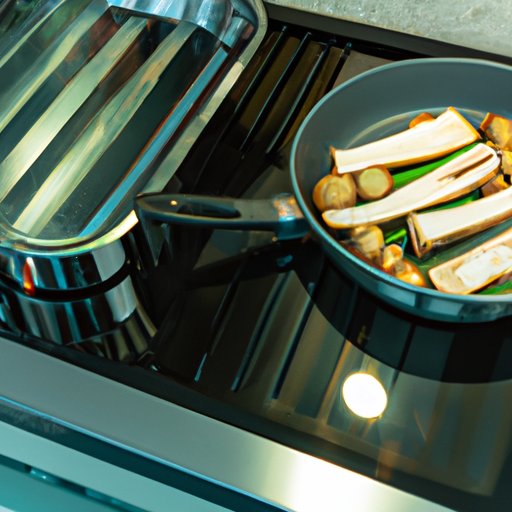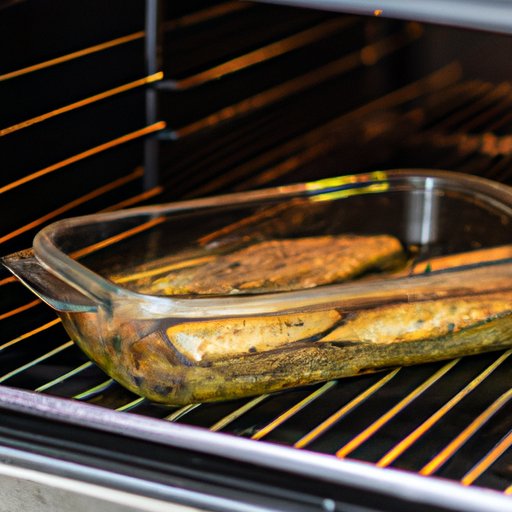
I. Introduction
Welcome to the ultimate guide to broiling! Broiling is a fantastic cooking method that can generate delicious and healthy meals in no time. If you’ve never broiled before, don’t worry! In this article, we’ll cover all the basics, from choosing broiling equipment to different broiling recipes and everything in between.
A. Definition of Broiling
Before we get started, let’s define the term “broiling.” Broiling is a cooking method that involves placing food, such as meat or vegetables, on a rack or broiler pan and exposing it to direct heat. This process cooks the food by browning and searing it on one side, then often flipping it to encourage a similar effect on the opposite side.
B. Why Broiling is a Great Cooking Method
Broiling is a great cooking technique because it is quick, easy, and healthy. Unlike frying or sautéing, broiling doesn’t require the use of additional fats or oils, which can make dishes less healthy. Additionally, broiling is a fantastic way to add flavor and texture to meats and vegetables.
C. Preview of the Topics Covered in the Article
In this article, we’ll cover a variety of topics related to broiling, from the equipment and preparation to different recipes and meal prep tips. Here’s a sneak peek at what you can expect:
II. The Ultimate Guide to Broiling: Tips and Techniques for Perfect Results
A. Explanation of Broiling Equipment
Before we dive into preparing food for broiling, let’s take a look at the equipment you’ll need. Broiling typically requires a broiler pan, which is a flat pan with a rack that fits inside. You can purchase a broiler pan separately or as part of a set with your oven. Other essential equipment includes tongs for flipping food and an instant-read meat thermometer to ensure meat is cooked to the appropriate temperature.
B. Preparing Foods for Broiling
Now that you have your equipment ready, it’s time to start preparing your food for broiling. When broiling meat, trim any excess fat to improve your dish’s healthiness. You can season meat using a variety of spices or marinades before cooking to enhance flavor. Vegetables can be broiled with a bit of oil, salt, and pepper, or even tossed in a marinade before cooking.
C. Broiling Time and Temperature Guidelines
The key to achieving a perfect broil is to cook food at the appropriate temperature and for the correct amount of time. Typically, thinner cuts of meat will take less time to cook than thicker cuts. You can use an instant-read thermometer to check the internal temperature of your meat and ensure it’s cooked to your desired level of doneness.
D. Tips for Achieving a Perfect Broil
Some tips for achieving a perfect broil include preheating your broiler for several minutes before cooking, broiling food on the top rack of the oven to prevent burning, and flipping food halfway through cooking.
III. Broiling 101: A Beginner’s Guide to the Fastest Cooking Method
A. Advantages of Broiling
In this section, we’ll focus on the advantages of broiling, particularly for beginners. Broiling is one of the fastest cooking methods, making it perfect for those on a tight schedule. Broiling is also incredibly versatile and can be used to cook a variety of foods, from meat and vegetables to fruit and even pizza.
B. Choosing the Right Foods for Broiling Beginners
Some foods are better suited for beginners than others when it comes to broiling. For example, chicken breasts, salmon fillets, and pork chops are all easy to prepare and cook quickly. These foods can also be seasoned in various ways to suit different tastes. Additionally, vegetables such as asparagus, peppers, and mushrooms are perfect for broiling and make great sides or additions to a meal.
C. Tips and Tricks for a Successful Broil for Beginners
For beginners, there are a few tips and tricks to keep in mind when broiling. These include using a timer to avoid overcooking, checking food frequently, and experimenting with different cooking times and temperatures.
IV. Top Mistakes to Avoid When Broiling and How to Fix Them
A. Common Mistakes When Broiling
Like any cooking method, broiling comes with its own set of common mistakes. These include burning food, undercooking meat, and failing to preheat the broiler.
B. Troubleshooting Tips When Broiling Fails
If your broiling fails, there are several troubleshooting tips you can try. For example, if you’ve burned your food, you can try lowering the broiler rack or adjusting the cooking time. If meat is undercooked, you can return it to the oven for additional cooking time or cover it with foil to prevent excess browning as it cooks.
C. Tips on How to Avoid Broiling Errors
To avoid common broiling errors, be sure to follow recipe instructions carefully, keep a close eye on your food, and practice controlling the broiling temperature with the oven settings or broiler pan’s distance from the heat source.
V. Spice Up Your Meals with These Creative Broiling Recipes
A. Introduction to Different Broiling Recipes
Now that you’re familiar with the basics of broiling, let’s take a look at some delicious and creative recipes you can make using this cooking method. From broiled flank steak to broiled citrus fruits, there are endless options to choose from.
B. Selection of Creative Broiling Recipes
Some examples of creative and flavorful broiling recipes include broiled teriyaki chicken, broiled salmon with brown sugar glaze, and broiled grapefruit with honey and ginger.
C. Different Tips and Techniques for Specific Broiling Recipes
Each broiling recipe comes with its own set of tips and techniques. For example, to make the perfect broiled teriyaki chicken, be sure to marinate your chicken before cooking, preheat your broiler, and use a meat thermometer to ensure proper cooking.
VI. The Pros and Cons of Broiling vs. Grilling
A. Comparison Between Broiling and Grilling
Broiling and grilling are both popular cooking methods, and it’s essential to understand the differences between them. While broiling involves placing food under direct heat, grilling involves cooking food over an open flame.
B. Advantages and Disadvantages of Broiling
Some advantages of broiling include the fast cooking time, easy preparation, and ability to cook foods with lower fat content. However, broiling can also be tricky and requires a bit of experimentation to achieve the perfect results.
C. Advantages and Disadvantages of Grilling
Grilling, on the other hand, is a great option for those who prefer the smoky flavor that comes with cooking food over an open flame. However, grilling can be time-consuming and requires frequent attention to prevent overcooking or burning.
VII. Broiling on a Budget: Affordable Cuts of Meat that Broil Beautifully
A. Different Types of Meat that are Perfect for Broiling
Broiling can be an affordable cooking method, especially if you choose the right cuts of meat. Some affordable and flavorful options for broiling include flank steak, London broil, and chicken thighs.
B. Strategies for Purchasing Affordable Cuts of Meat
To save money on meat purchases, look for manager specials, shop in bulk, or consider purchasing meat when it’s on sale. Additionally, consider purchasing frozen meat, which can often be more affordable than fresh cuts.
C. Tips for Properly Broiling Cheaper Cuts of Meat
To properly broil cheaper cuts of meat, marinate them before cooking, avoid overcooking, and use a meat thermometer to ensure doneness.

VIII. Broiling for Meal Prep: How to Cook and Store Broiled Foods for the Week
A. Explanation of Broiling for Meal Prep Purposes
Broiling can be a fantastic method for preparing meals in advance. Cooking a large batch of protein or vegetables at one time can save time throughout the week.
B. Tips for Preparing Broiled Food for the Week
To prepare broiled food for the week, be sure to cook it until it’s almost fully cooked, leaving a bit of “wiggle room” to prevent overcooking. Additionally, you can portion out the food in advance and store it in airtight containers.
C. Different Storage Methods for Broiled Foods
Broiled food can be stored in the refrigerator for up to five days or in the freezer for several months. Be sure to label your food with the date you cooked it, so you know when it’s time to consume it.
IX. Conclusion
of Key Points from the Article
Throughout this article, we’ve covered everything you need to know about broiling, from the equipment and preparation to different recipes and meal prep tips. Remember, the key to a successful broil is proper preparation, attention to cooking temperature and time, and a willingness to experiment with different cuts of meat and seasoning combinations.
B. Final Thoughts on Broiling as a Cooking Method
Broiling is a fantastic, fast, and easy cooking method that can help you prepare healthy and delicious meals in no time. Whether you’re a beginner or a seasoned home cook, give it a try and experiment with different foods and techniques to find your perfect broil.
C. Call-to-Action for Readers to Try Broiling as a Cooking Method
We hope this guide has inspired you to try broiling your next meal. Take what you’ve learned here and experiment with different combinations of spices, cuts of meat, and vegetables to find your perfect broil.





